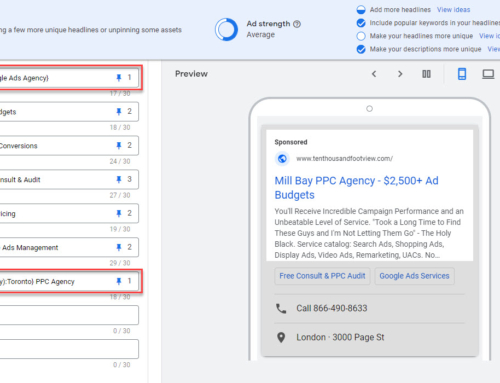Google Ads remarketing has been a key part of the funnel for many years. Whether using GDN, RLSAs, YouTube or Discovery, most advertisers generate a nice volume of incremental conversions.
But recently I’ve noticed a pretty significant change happening. Some of these changes resulted from external forces such as what third parties are up to or Google having to address consumer privacy concerns. Some of these changes are just decisions Google is making internally.
So what’s up with Remarketing lately and what’s Google’s end game?
In this article, I’m going to explore the recent changes and also make some predictions about the future of Google Ads remarketing.
The Big Remarketing Shake-Up
Here’s what I’m seeing recently that makes me believe things are shifting for remarketing.
Apple Privacy Controls
Ever since the big Apple privacy lockdown (April 2021) we’ve seen a substantial drop in GDN and YouTube remarketing performance. This isn’t surprising, since most Apple devices can’t be tracked or targeted. The industry has broadly responded by reducing ad spend on these remarketing channels. At our agency, we’ve migrated most clients to remarketing on Discovery Ads. While not having nearly the reach of GDN, Discovery offers premium Google-owned inventory and targets “logged-in” users. Those features have made this channel a big winner for our clients.
Alas, all isn’t well with Discovery Ads, as I’ll cover at the end of this section.
Performance-Max Takeover
With the dramatic ramp-up of P-Max campaigns over the past year, it’s become clear that most advertisers are no longer running dedicated Google Ads remarketing campaigns. Pitched as full-funnel marketing, P-Max covers all of Google’s inventory and targets audiences automatically. One would assume, then, that remarketing is built-in. And it is, well sort of.
P-Max offers dynamic remarketing for shopping ads. P-Max does not offer remarketing for lead-generation (non-shopping-feed) campaigns. Yes, that’s right! Since targeting is performed via audience signals, you cannot target remarketing lists specifically.
Okay, so this doesn’t prevent advertisers from running separate remarketing campaigns. But many have stopped doing that, simply assuming Google is taking care of it.
Third-Party Cookies and First-Party Data
Once third-party cookies are removed from Google Chrome next year, we’ll have far less visitor data for audience building. Google is in the process of replacing cookies with something else. What the something else still isn’t very well defined. But it seems pretty certain that it won’t be a method to track individual users.
As such, this is probably the death knell for visitor remarketing.
Sure, we’ll still have first-party data, but those lists are tiny for many small businesses. Also, other than newsletter subscribers, most lists are made up of existing customers. For advertisers only interested in lead generation, that list is generally useless for remarketing efforts.
The Demise of Similar Audiences
This August Google will be nixing similar audiences. While similar audiences aren’t for remarketing per se, I believe the similar audiences “system” is being replaced by audience signals. If this is true, it means that Google will probably roll it out to other campaign types sooner rather than later. Once this is done, say goodbye to stand-alone remarketing campaigns.
And this is already starting to happen…
Audience Signals in Discovery Ads
Just a few months ago, Google made a pretty fundamental change to the way Discovery Ads work. Instead of directly targeting audiences, Discovery has adopted the P-Max methodology. This means you have to use audience signals. Therefore, there is no longer any way you can run a remarketing-specific Discovery Ads campaign.
As such, advertisers that found a safe haven for remarketing now have to either (a) revert to far less effective GDN and/or video remarketing or (b) shut down remarketing completely.
Neither option is attractive, obviously.
Useless RLSAs
Most advertisers are running remarketing lists in their search campaigns. But the combination of observation and automated bidding means that there is no meaningful way to raise bids for those target groups.
Thus RLSAs really only exist if you run them in target mode, excluding non-remarketing users in that campaign or ad group. And that really only makes sense for fairly large spend advertisers…. we’re talking 6-figure/month and up.
Google’s Motivations to Remove Remarketing
Honestly, I think most of the forces towards nixing remarketing are external. There are pressures from regulators and consumers to improve privacy controls. Once Google goes down the road of removing cookies it’s going to be difficult, at best, for anybody to be excited about remarketing. It’s already clearly less effective than it was before Apple’s big shake-up.
Given this, Google can either let remarketing run on fumes or evolve targeting to integrate or eliminate it.
What’s Next for Google Ads Remarketing?
I cannot think of any other reason that Google would change Discovery Ads like this unless they plan the same elsewhere.
My guess is that Google will roll out Audience Signals as the default targeting option for Search and Display campaigns by the end of the year. As with Discovery Ads, this will mean no direct targeting option, but existing “remarketing” and other audience-based campaigns may continue to run for some time.
As for the remarketing audiences themselves, they will likely continue to exist but will only be valuable for building audience signals and perhaps exclusions moving forward.
The whole situation is similar to the systematic elimination of keyword targeting that’s slowly been happening over the years.
On the other hand, Google may plan to somehow integrate remarketing into audience signals. For example, they could allow an option to directly target and bid on individual audiences. Or they could simply offer a “remarketing” checkbox that includes all of the appropriate lists. Under this scenario, you would be including remarketing as part of your audience signals. It sounds nice but in practice, we know that remarketing lists won’t get much budget love. That means we’re not really any better off.
And then there is dynamic remarketing to consider. This is a pretty big component part of shopping in P-Max. What happens to this moving forward is anybody’s guess.
Summary
Clearly, I don’t have all the answers to what the future of Google Ads remarketing will look like. But the trajectory will seem to take us towards fewer remarketing options. We’re at a point now, where remarketing has become far less attractive.
Display Ads can convert when you get it right, but it’s an uphill battle with blocked Apple devices and the heavy dose of sophisticated click fraud advertisers face.
Realistically Google Ads remarketing may be toast by the time 2024 rolls around.






